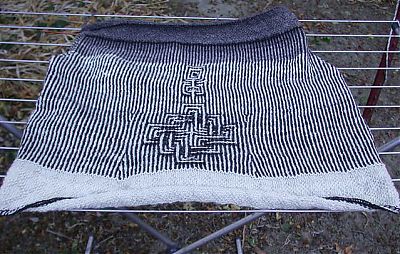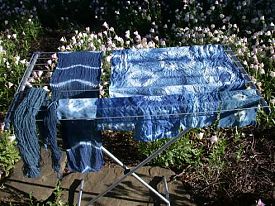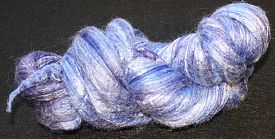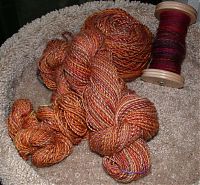2 December 12
Fibershed
A couple of weeks ago I went with a couple of friends to the Fibershed Symposium in Point Reyes Station. This is a group of people led by Rebecca Burgess (brilliant author of Harvesting Color and passionate advocate of locally-grown and produced textiles) who aim to transform the amazing resources we have in Northern California into a self-sustaining industry so the wool that is grown here can be used rather than thrown away (or shipped to China to be processed there and shipped back).
We heard from local growers (of whom one was Robin Lynde of Meridian Jacobs, where I am a Farm Club member) about the joys and challenges of raising fiber animals in our region. One of the shepherds has Marenna dogs to guard the sheep against coyotes; vet bills for her dogs have to factor into the cost of raising the wool. You have to factor in the cost of irrigating pasture in a region where there is little to no rainfall from April to October. (Pasture health is a prime concern for sustainable farmers.) You have to factor in vet bills for the sheep as they always, as Pratchett’s Granny Aching says, look “for new ways to die.”
We also heard from sheep shearers, whose perspective on fleece quality is not often heard, and from two people with crazy exciting ideas for starting fiber/textile processing plants here in Northern California.
 Rebecca spent a year wearing clothes, including underwear, that had been grown and produced within 150 miles of her home in Petaluma. This is a tall order but taking a cue from her, I’ve designed, spun, and am knitting a vest that I hope will replace my polartec one. It needs to be tough; it needs a zipper up front and on two side pockets; it needs to be able to handle my keys in the pocket; it needs to be wind-and-rain-resistant.
Rebecca spent a year wearing clothes, including underwear, that had been grown and produced within 150 miles of her home in Petaluma. This is a tall order but taking a cue from her, I’ve designed, spun, and am knitting a vest that I hope will replace my polartec one. It needs to be tough; it needs a zipper up front and on two side pockets; it needs to be able to handle my keys in the pocket; it needs to be wind-and-rain-resistant.
I discovered the Swedish technique of twined knitting when I first got back into knitting after a 25-year absence, and it’s the reason I learned how to spin, since yarn for this technique is typically spun and plied in the opposite directions of most commercial yarns. The fabric is taught but not as much as woven, making it ideal for this kind of outer garment; it doesn’t shrink or felt when wet. I also wanted to showcase the beauty of the multi-colored Jacob sheep.
 I spun the yarn from the fleece of a sheep named Summer but ran out close to the collar. (Note to self: you don’t really need to do 4-ply sport weight…) The good news about sheep though is that they’re always growing more.
I spun the yarn from the fleece of a sheep named Summer but ran out close to the collar. (Note to self: you don’t really need to do 4-ply sport weight…) The good news about sheep though is that they’re always growing more.
 Here are some locks from Summer’s fleece, shorn in early November; her dark spots have lightened over the two years but it’s lovely, soft, and a joy to spin. These locks were soaked in rainwater, then spent 3 days in a fermented suint vat, then rinsed in rainwater. No heat/energy required…
Here are some locks from Summer’s fleece, shorn in early November; her dark spots have lightened over the two years but it’s lovely, soft, and a joy to spin. These locks were soaked in rainwater, then spent 3 days in a fermented suint vat, then rinsed in rainwater. No heat/energy required…
Finally, here I am with Summer right after she was shorn. There’s something very satisfying about making a garment from an animal you know personally…

29 May 11
Indigoing
 I attended a workshop in Berkeley yesterday put on by the Spindles and Flyers group (lovely to see Lisa there). It was an indigo dyeing workshop using greener chemicals. This doesn’t mean we fermented a pot of indigo for ten days in urine, which is also a green method; we used slake lime, iron phosphate, and indigo. (The more toxic combinations from the nineteenth century involved sodium hydrosulphite and zinc-lime formulas.)
I attended a workshop in Berkeley yesterday put on by the Spindles and Flyers group (lovely to see Lisa there). It was an indigo dyeing workshop using greener chemicals. This doesn’t mean we fermented a pot of indigo for ten days in urine, which is also a green method; we used slake lime, iron phosphate, and indigo. (The more toxic combinations from the nineteenth century involved sodium hydrosulphite and zinc-lime formulas.)
Barbara Shapiro encouraged us to bring personal projects to dye (I brought some Jacob handspun, woolen spun three plies; it’s at the lower left in the photo). She gave us samples to try different shibori resist techniques on — cotton, linen, rayon, silk, and wool. The same exact exposure to the dyebath produces very different results depending on the material being dyed. Wool produces a sort of Prussian blue, “sad” blue as Barbara called it. Silk doesn’t take the dye so strongly and leaves sections that are more yellow, making the whole look like a cyanotype. Rayon takes the dye very quickly and strongly. Cotton and linen make a beautiful deep blue. We learned that Japanese master dyers sometimes do 18 dippings to get a rich, deep blue. (The only piece I dipped more than once is the scarf at the upper left; it was dipped twice. Now that it’s dry it’s much lighter than in the photo. I can see dipping 5 or 6 times. The caustic solution is not good for wool so I wouldn’t want to do more than 3 or 4 for wool, though.)
Oxidation is what makes this work — the fabric is green in the dye bath and on contact with air almost immediately turns blue. It’s magical. We were all sent home with residual dye from the class and I have some plans for some undyed merino-silk.
21 April 11
Gasland
This evening Numenius and I went to see Gasland, highly recommended if you get the chance and have the stomach for the ticking time-bomb aspect of unregulated and very dangerous drilling practices. Natural gas as the answer to the US’s insatiable and unsustainable demand for energy? No thanks.
In other news: my silkworms all died, victims of an attack by ants and the unseasonably cold weather. A second “feral” cat was caught and is now happily a member of a household with two other cats and a baby. The first cat, Elspeth, is not doing so well in her new home — she just wants to play but is terrorizing the older male cat who will now not eat. She’s sweet and full of energy, healthy and needs a new home. Holler if you can give her one or know someone who can.
And I bought my first fleece yesterday: it’s a Jacob fleece from a ewe named Summer from Meridian Jacobs. I joined the Farm Club, which gives you a fleece and a logo item (I got a green apron, good for carding on) and the chance to go help out on days where vaccinations or shearing or lambing are happening. I delayed a while because I was intimidated by the perceived difficulty of processing a fleece. But having seen Margaret Stove’s video, Spinning for Lace, I see there are very easy ways to do this, in small chunks. This, I can do. I’m going to prepare this fleece for the Tour de Fleece in July which coincides with the Tour de France.
7 April 11
A Wooly Weekend
 On Saturday I left Numenius at the Let’s Draw Davis event so I could go to the Meridian Jacobs Open House. Lots of lambs — over 60 — and spinning, felting, a festival atmosphere. One group from Elk Grove brought their picnic and their Chardonnay and had a rare old time.
On Saturday I left Numenius at the Let’s Draw Davis event so I could go to the Meridian Jacobs Open House. Lots of lambs — over 60 — and spinning, felting, a festival atmosphere. One group from Elk Grove brought their picnic and their Chardonnay and had a rare old time.
 I’ve been spinning some Wensleydale and took my wheel along so I could spin with a small group. It’s a lovely fiber to spin and I was able to get this one much finer than my first couple of attempts. The luster is astonishing and knitting with it is reminiscent of mohair (don’t make mistakes because ripping it out is a pain).
I’ve been spinning some Wensleydale and took my wheel along so I could spin with a small group. It’s a lovely fiber to spin and I was able to get this one much finer than my first couple of attempts. The luster is astonishing and knitting with it is reminiscent of mohair (don’t make mistakes because ripping it out is a pain).
 On Sunday, after a trip up to Cold Canyon, I attended the memorial service for a friend and fellow knitter, “Nancy Seyden.” She was an amazing person and a fantastic advocate for disability rights in our region. She was a kickass knitter. She was also a docent at the Yolo Wildlife Area and I have donated my Delta socks (framed by my sister and with a generous donation from 100 Acre Wood in Norway, Maine) to the Foundation in her honor.
On Sunday, after a trip up to Cold Canyon, I attended the memorial service for a friend and fellow knitter, “Nancy Seyden.” She was an amazing person and a fantastic advocate for disability rights in our region. She was a kickass knitter. She was also a docent at the Yolo Wildlife Area and I have donated my Delta socks (framed by my sister and with a generous donation from 100 Acre Wood in Norway, Maine) to the Foundation in her honor.
Baseball’s back. It’s fabulous. Spinning and baseball on the radio, how can you go wrong?
26 March 11
Spinning for Socks
I’ve been working on my spinning skills for making sock yarn. Socks need to fit well for comfort and also wear — the trick is to minimize abrasion so the wool scales don’t break and expose what’s left to further abrasion. Holes in heels and toes are common. After all this work, they break your heart.
 My class with Janel Laidman at Stitches West in February was excellent. Some tricks to making a durable yarn are a) the strength of the material itself (nylon, silk, and mohair are much stronger fibers than wool); b) wool preparation (combed top is better than carded roving for socks because the fibers align neatly, reducing abrasion again); c) spinning method, making the most of these aligned fibers, i.e. worsted spinning vs. woolen spinning; d) hiding as much of the surfaces of each strand within the plied structure, such as with cable plying or multiple-strand plying; e) even spinning (cutting down on abrasion again, and accomplished easily by slowing down the treadling once you’ve learned how to spin); f) a tight ply; g) a tight knit. (The most important one of all of these, as far as I can tell, is the last; recommendations by the contemporary wool industry about what gauge to knit at are woefully inadequate for wear and would have been laughed at by our ancestors—see Aaron Lewis for exhaustively more on this).
My class with Janel Laidman at Stitches West in February was excellent. Some tricks to making a durable yarn are a) the strength of the material itself (nylon, silk, and mohair are much stronger fibers than wool); b) wool preparation (combed top is better than carded roving for socks because the fibers align neatly, reducing abrasion again); c) spinning method, making the most of these aligned fibers, i.e. worsted spinning vs. woolen spinning; d) hiding as much of the surfaces of each strand within the plied structure, such as with cable plying or multiple-strand plying; e) even spinning (cutting down on abrasion again, and accomplished easily by slowing down the treadling once you’ve learned how to spin); f) a tight ply; g) a tight knit. (The most important one of all of these, as far as I can tell, is the last; recommendations by the contemporary wool industry about what gauge to knit at are woefully inadequate for wear and would have been laughed at by our ancestors—see Aaron Lewis for exhaustively more on this).
All of the above is great except you can end up with chain mail for your feet if you’re not careful, so spinning sock yarn is an exercise in balancing strength with softness. Instead of spinning hard and plying hard, you can spin soft and ply hard, which results in smooth curved ridges along the yarn rather than straight-as-a-ruler stuff. So Janel had us combining merino (soft) with blue-faced leicester (strong AND soft, a longwool which is sort of ideal for socks all on its own); plying different fibers together (one strand of mohair to two of BFL plus one of merino, for instance. A compromise that can be made at the level of spinning is long-draw (a woolen spinning technique) from a combed top (worsted preparation) to make a semi-worsted strand.
In a grand finale to this class Janel made an ideal blend for socks on the drumcarder: BFL, cashmere, nylon, merino. It made me lust after a drumcarder but they’re expensive and bulky and scary sharp, not necessarily a wise addition to a 600-sf space with two cats.
 My experiments have led to a wider-than-hoped for yarn that I’ve cable-plied: two strands of plied yarns plied together the opposite direction, locking the “bumps” in together. I’ve combined separate strands of mohair with BFL and merino in different proportions and will knit the stronger strands along the foot rather than up the leg…. These will make good socks for my new Wellingtons, bought on Friday because we seem to be drifting off into the Delta, here.
My experiments have led to a wider-than-hoped for yarn that I’ve cable-plied: two strands of plied yarns plied together the opposite direction, locking the “bumps” in together. I’ve combined separate strands of mohair with BFL and merino in different proportions and will knit the stronger strands along the foot rather than up the leg…. These will make good socks for my new Wellingtons, bought on Friday because we seem to be drifting off into the Delta, here.
I’m calling this colorway San Lorenzo, and may design a sock that reflects the martyrdom of this particular saint, who is reputed to have told the folks cooking him on a gridiron that he was done on that side and could be turned over now, thanks.
14 November 10
Shearing Day
 I took a friend down to Meridian Jacobs farm yesterday to see the sheep shearing. Robin Lynde has about 60 Jacob sheep but there were other sheep too, brought in to take advantage of the speed and skill of a master shearer.
I took a friend down to Meridian Jacobs farm yesterday to see the sheep shearing. Robin Lynde has about 60 Jacob sheep but there were other sheep too, brought in to take advantage of the speed and skill of a master shearer.
 It is very hard to sketch a sheep during the process of shearing because it all happens so quickly, and the sheep is turned left, right, over — but this sketch gives a sense of that in an odd way. This was a dark silver Wensleydale ram whose name is Marley. You don’t shear the forelocks on Wensleydales and after he was shorn I went over to say hello. He is a gorgeous fellow with wrinkles on his nose and came right up to me in the friendliest way. Rasta sheep…
It is very hard to sketch a sheep during the process of shearing because it all happens so quickly, and the sheep is turned left, right, over — but this sketch gives a sense of that in an odd way. This was a dark silver Wensleydale ram whose name is Marley. You don’t shear the forelocks on Wensleydales and after he was shorn I went over to say hello. He is a gorgeous fellow with wrinkles on his nose and came right up to me in the friendliest way. Rasta sheep…
I bought a lambskin from Robin, some Jacob horn buttons, and a beginning weaving book.
1 September 10
My New Buddy
 On Sunday we went up to Placerville to visit the studio of dyer and spinner extraordinaire, Lisa Souza. We took two knitters with us — one a friend from Davis, another a knitter from Baltimore we sort of adopted since she was working in Sacramento for a month. Numenius went for a bike ride while Laura, Cami and I got lost in some serious yarn for a while.
On Sunday we went up to Placerville to visit the studio of dyer and spinner extraordinaire, Lisa Souza. We took two knitters with us — one a friend from Davis, another a knitter from Baltimore we sort of adopted since she was working in Sacramento for a month. Numenius went for a bike ride while Laura, Cami and I got lost in some serious yarn for a while.
 I had asked Lisa to dye me some fiber in her “Electra” colorway. The fiber is 50% merino, 25% silk, 25% bamboo, and it drapes in the most gorgeous way. Because 75% of the fibers are animal protein but silk and merino take dye at different rates, and because bamboo won’t take acid dye at all, the effect is shimmery and magical.
I had asked Lisa to dye me some fiber in her “Electra” colorway. The fiber is 50% merino, 25% silk, 25% bamboo, and it drapes in the most gorgeous way. Because 75% of the fibers are animal protein but silk and merino take dye at different rates, and because bamboo won’t take acid dye at all, the effect is shimmery and magical.
As I was paying for this, I noticed a dark blue-green bump of fiber in her dyeing studio. It’s Wensleydale. I shuddered and put it down — too scary. I’ve heard dozens of stories of people—good spinners—turning this super-long stapled wool into piano wire. Lisa looked at me and laughed. “It’s because they don’t listen to me,” she said. “You have to spin really low-twist and let it go, let it go, let it go.”
 Let it blossom, let it snow. I have a new best friend. Two days later, I’ve finished spinning the undyed fiber she gave me to practice with and am halfway through the blue-green.
Let it blossom, let it snow. I have a new best friend. Two days later, I’ve finished spinning the undyed fiber she gave me to practice with and am halfway through the blue-green.
The photo of the Wensleydale sheep, above, is taken by the super-talented Birdwoman of the Birdwoman Knits blog, and I’m grateful to have such a splendid creature gracing the walls of Feathers of Hope. That’s a 10-11” staple, folks.
23 July 10
Tour de Fleece
 As you might have guessed from the photos, below, I’ve been spinning a lot lately. I’m participating in the Tour de Fleece, which is a (fiber) spinning event that coincides in time with the Tour de France. Different categories separate different spinners, and you can join teams. I’m in Team Rookies since it really is less than a year since I got my wheel, hard to believe. I’m also in Team JulieSpins because the fiber I’m spinning — a soft-as-butter Blue-faced Leicester — was dyed by the hugely talented Julie Sandell of Massachusetts, whose work can be found here and here.
As you might have guessed from the photos, below, I’ve been spinning a lot lately. I’m participating in the Tour de Fleece, which is a (fiber) spinning event that coincides in time with the Tour de France. Different categories separate different spinners, and you can join teams. I’m in Team Rookies since it really is less than a year since I got my wheel, hard to believe. I’m also in Team JulieSpins because the fiber I’m spinning — a soft-as-butter Blue-faced Leicester — was dyed by the hugely talented Julie Sandell of Massachusetts, whose work can be found here and here.
 The Tour de France ends on Sunday, and I find myself gathering my wits, cats, and early hours to try and get all the fiber spun. I separated all 30 ounces out into vague color likenesses, and decided on a traditional 3-ply (versus Navajo, or chain, ply, which would have preserved longer color repeats but which is inherently less stable and uneven than the teutonic solidity of a 3-ply). I could have made this a lot easier for myself and gotten a lot more yarn if I’d chosen a 2-ply, but 3-ply blends the colors better and the yarn is more rounded.
The Tour de France ends on Sunday, and I find myself gathering my wits, cats, and early hours to try and get all the fiber spun. I separated all 30 ounces out into vague color likenesses, and decided on a traditional 3-ply (versus Navajo, or chain, ply, which would have preserved longer color repeats but which is inherently less stable and uneven than the teutonic solidity of a 3-ply). I could have made this a lot easier for myself and gotten a lot more yarn if I’d chosen a 2-ply, but 3-ply blends the colors better and the yarn is more rounded.
I’m going to use this stuff to make a side-to-side jacket, inspired by kimono construction but tapered at the waist by means of short rows. Designing as you go results in some ripping out. I don’t mind this, I’ve discovered. Maybe in my old age i really am becoming more patient. I just hope I have enough yarn…
Yellow, pinky yellow, pinky magenta, magenta plum: I’m calling this yarn Nectarinada.
Added July 26, 2010: I finished the whole 2.5 lbs. It’s dense!!

17 July 10
21 January 10
Joyce While Spinning
I’ve started listening to Ulysses while working on some hand-dyed (not by me) merino wool. I’m planning fingering/sock weight. It’s beautiful at least in singles, we’ll see what it looks like plied.
I couldn’t get the second CD to work for some reason and am a thwarted Joycean. Loving the language, the exuberance.
It’s still raining.


